For the second year in a row we’ve spent the first few weeks of the year surveying hundreds of marketers to assess their agility (or lack thereof). With the help of the Agile marketing team at CoSchedule, we’re delighted to present the Second Annual State of Agile Marketing Report.
And so, also for the second consecutive year, I’m conducting a deeper dive into our findings.
This article will walk you through some of the year-over-year trends, why some data points fluctuated in unexpected ways, and generally give more context to the survey and its results.
If you haven’t checked out the complete report grab it here, and then get ready to geek out on some awesome Agile marketing insights.
The Highlight Reel
Feel free to jump down and check out your favorite data points below, or just hit the highlights right here:
- 32% of the 400+ marketers we surveyed labeled themselves Agile. While this is down from 37% last year, some demographic changes in our respondents may explain the slight dip (more on that below).
- Half of traditional marketing teams say they’re planning to begin their Agile transformations within a year. The time is now, my fellow marketers!
- Lack of education remains the top barrier to Agile marketing adoption at 31%, but it’s followed closely by the belief that current processes are “working well enough” at 27%.
- Hybrid frameworks are becoming increasingly common on Agile marketing teams, with 54% of Agile respondents saying this is how they approach their process. This is a big jump from 2018, when only 44% reported the use of hybrid frameworks.
- Agile marketing teams say that the consistent use of processes and practices across teams (45%), online training and webinars (33%), and the implementation of an Agile project management tool (32%) are the most important components of a successful move to Agile.
- The benefits of marketing agility abound, with the ability to change gears quickly and efficiently (53%), better visibility into project statuses (44%), and identifying roadblocks and problems sooner (40%) getting the most votes from Agile marketing teams.
About the Survey Respondents
The most important thing for you to know about our 2019 respondents compared to last year’s panel is that we had a smaller percentage of upper level marketers responding this year.
| Reported Job Roles | 2018 Data | 2019 Data |
| Marketing Associate | 5% | 31% |
| Marketing Manager | 11% | 32% |
| Director | 43% | 18% |
| VP/Senior VP | 21% | 3% |
| Business Owner | Not asked | 15% |
I think there are several interesting outcomes from this distinction, which I’ll note as we go through some of the results below.
This kind of swing is one of the pitfalls of using a panel, which is how we’ve collected our data for the past two years. If you’re not familiar with the term, survey panels are a collection of people who’ve signed up to complete surveys for payment, and they’re a great way to quickly reach a diverse audience.
But the trade off is that you don’t ever know exactly who you’re going to reach.
We include disqualifying questions to ensure that we’re getting input from actual marketers, but we don’t limit the kinds of marketers who answer (at least we haven’t yet). One of next year’s iterations is likely to be placing limits on the number of associates and managers we accept responses from so we can get a broader perspective.
I believe we’re seeing a bit more honest data this year because we got a higher percentage of “in the trenches” marketers.
In my experience, VPs and CMOs are more likely to give aspirational answers; they tend to say their teams are more productive and more Agile than they really are.
Sometimes this is because they don’t see what’s really going on with the team, and sometimes it’s because they wish their departments were performing better.
Whatever the root cause, you’ll see some swings in data from the 2018 results on a few points.
I’ll unpack those whenever I think I have a good explanation. Sometimes that’ll be this demographic shift in the respondents, other times it will come from another cause.
Of course, if you have an alternative theory I’d love to hear it in the comments!
What Kind of Marketers Answered
Speaking of our respondents, let’s take a moment to learn a little more about them beyond their job roles.
We had fairly strong representation from most organization sizes, with some skewing towards smaller organizations.
How many employees are in your entire organization?
- Fewer than 100: 50%
- 100-499: 20%
- 500-1,000: 8%
- 1,001-5,000: 9%
- More than 5,000: 13%
How many total employees, including freelancers, are in your company’s marketing organization?
- 10 or fewer: 46%
- 11-30: 19%
- 31-50: 12%
- 51-70: 6%
- More than 70: 17%
We also saw a good mix of B2B, B2B, and combo teams:
How would you classify your organization?
- B2B: 24%
- B2C: 21%
- A mix of both: 40%
- Nonprofit: 11%
- Government: 4%
As with last year, the vast majority of respondents (96%) came from North America.
We disqualified several hundred respondents who either didn’t classify themselves as marketers or failed a very basic question about marketing. I’ve always been sensitive about getting good data for these reports, so we take our vetting seriously!
Changing Adoption Levels
As noted in the highlights section, our 2019 data shows a 5% decline in Agile marketing adoption over last year. While I was (of course) hoping to see an uptick here, I attribute the dip to the changing demographics of our respondents.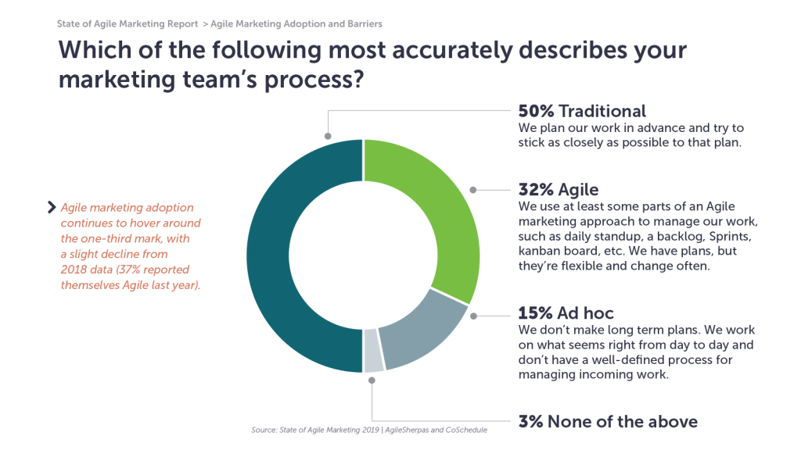
Just under one third of marketers characterize themselves as Agile.
Having worked with dozens of marketing teams and heard the different ways the same work is described by executives and associates, these numbers honestly align to my expectations.
VPs and CMOs like to say their teams are Agile (even if they’re not really sure what that means). Agility is becoming such an important part of marketing that any good marketing leader wants to be on board.
But unfortunately the reality of day-to-day work doesn’t always reflect that aspiration.
On a more optimistic note, a CMO or VP is also more likely to be aware of an Agile marketing pilot or experiment happening in one pocket of the organization. An associate, on the other hand, typically only knows what’s happening on his/her team.
So Agile might actually be happening somewhere in a large department, unbeknownst to the associate who completed our survey.
While 5% fewer marketers labeled themselves Agile this year, nearly 10% more identified themselves as traditional (keen on up-front planning and sticking to that plan). Fewer people also picked the Ad hoc label (down from 18% to 15%).
Agile Marketing and Happiness
This decline in Ad hoc marketers isn’t surprising, given how dissatisfied this type of marketing team tends to be.
Fifty-eight percent of Agile team members say they’re either satisfied or very satisfied with the way their department manages work, while only 32% of Ad hoc marketers say the same.
On the flip side, Ad hoc marketers are more than twice as likely to say they’re either dissatisfied or very dissatisfied with their work management approach.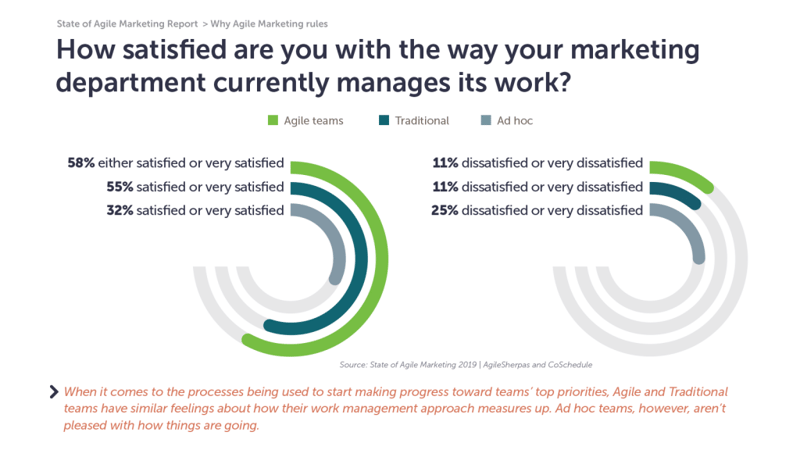
Ad hoc marketers aren't very happy with their operations.
Interestingly, this year’s report places the happiness levels of traditional and Agile marketing teams very close.
That similarity not withstanding, 33% of Agile marketing teams say they’re enjoying improved team morale following their move to Agile. Since most Agile marketing teams are still quite young, we may be looking at some lag time between going Agile and the happiness uptick.
Given other data from MarketingProfs that was released earlier this year about marketers’ general level of stress and overwork, I’m interested to see what longitudinal views we get in the next 2-3 years on increased levels of satisfaction on Agile teams.
Before and After Agile Marketing
One of the most important things we ask marketers is why they went Agile in the first place, and then what benefits they’re reporting after an Agile transformation.
Essentially, we’re trying to determine whether marketers are getting the results they hoped for by using Agile principles and practices.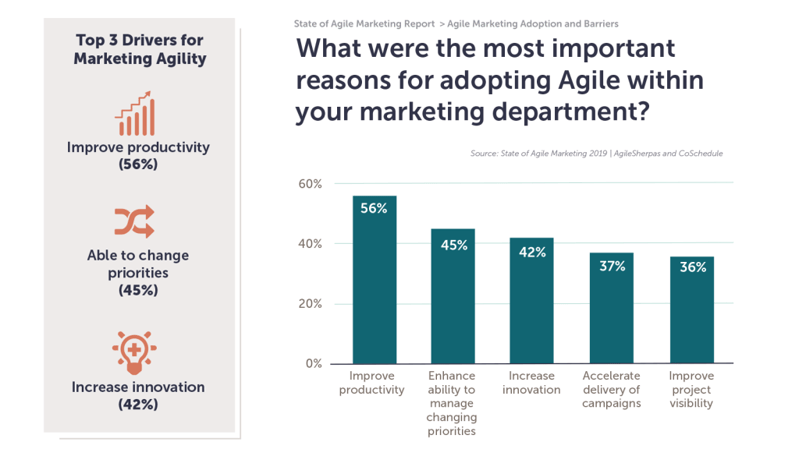
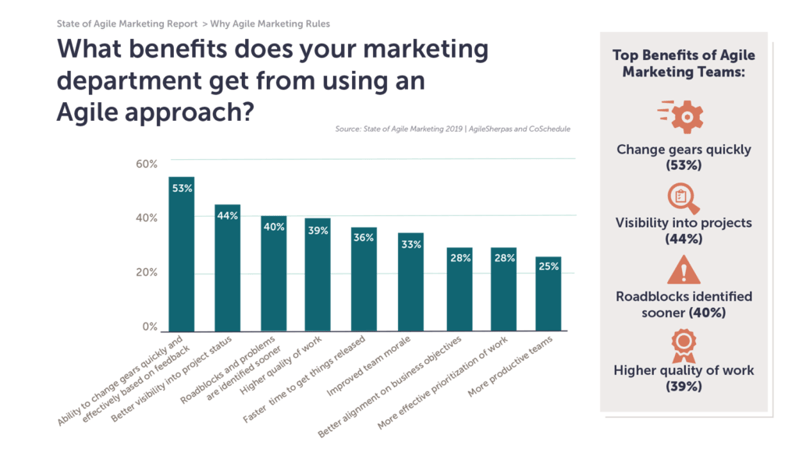
(In both of these questions respondents could choose as many benefits as they liked, so the results don’t add up to 100%.)
As you can see, the top three drivers reported were improving productivity (56%), better managing changing priorities (45%), and increasing innovation (42%).
Responding the change quickly and effectively is definitely being achieved, with 53% of Agile marketing respondents citing it as a benefit.
While the benefits and drivers aren’t phrased exactly the same way, it’s easy to see the connection between productivity and visibility into projects (reported by 44% of Agile marketers) and the ability to identify problems sooner (reported by 40%).
Likewise, there’s likely to be a strong correlation between higher quality work (a benefit enjoyed by 39%) and a desire for more innovative marketing work (reported by 42%).
What Agile Marketing Really Looks Like
Now that we’ve spent a little time on the why’s behind Agile marketing, let’s take a closer look at what it looks like in the wild.
For the purposes of our survey, a quick reminder of how we characterize the three kinds of marketing teams:
Agile: We use at least some parts of an Agile marketing approach to manage our work, such as daily standup, a backlog, Sprints, kanbcn board, etc. We have plans, but they’re flexible and change often.
Traditional: We plan our work in advance and try to stick as closely as possible to that plan.
Ad hoc: We don’t make long term plans. We work on what seems right from day to day and don’t have a well-defined process for managing incoming work.
(You can read (a lot) more about what Agile marketing really is in these two detailed articles.)
Agile Marketing Frameworks
When it comes to actual teams, the most commonly used approach is a hybrid framework: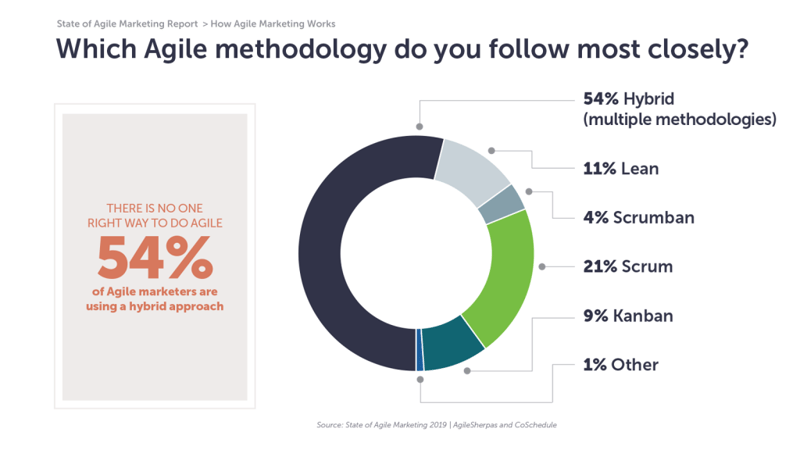
This result makes me very, very happy, because our work with over 1,000 Agile marketers has proven time and time again that hybrid frameworks are the most effective for Agile marketing teams.
Ten percent more Agile marketers reported using a hybrid framework this year than last. Other year-over-year changes include:
- 3% more Agile marketing teams report using Scrum, but this is still far below the 58% of Agile software teams that prefer this framework.
- Both Kanban and Scrumban declined year over year, Kanban by 3% and Scrumban by 6%.
While the qualitative experience of our AgileSherpas tells us that hybrids are the most effective way to implement Agile marketing, this year we found a quantitative data point to support that view.
When we compared the different frameworks being used with the benefits being reported by Agile marketing teams, we found that hybrid frameworks are more likely to deliver Agile benefits: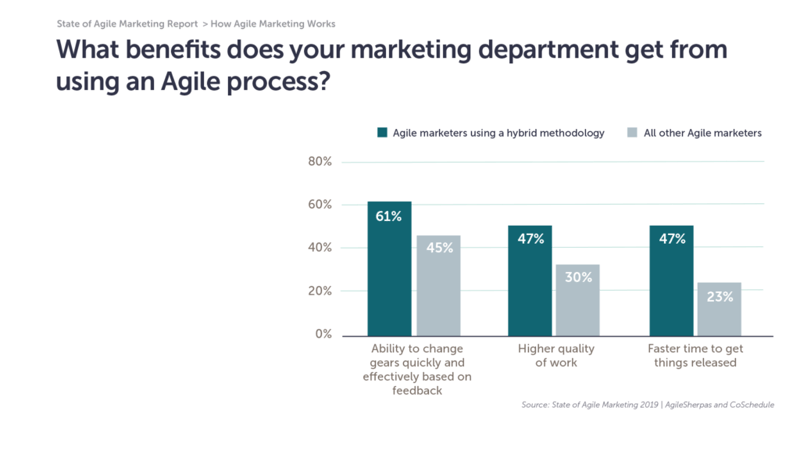
You’ll see a 16% increase in the ability to respond to change, 17% increase in the ability to produce high quality work, and a 24% increase in release speed for hybrid Agile marketing teams.
Our experience has made flexibility a foundational principle of our Agile marketing training styles, and I have to say it was delightful to see its power proven by this year’s data.
Agile Marketing Practices
Within all these Agile marketing frameworks, some particular practices emerge as the most commonly used. The list below shows the most popular choices from our Agile respondents:
- 44% Daily standup
- 42% User stories
- 32% Retrospectives
- 31% WIP (Work in Progress) limits
- 28% Short iterations
- 27% Sprint/iteration planning
- 26% Frequent releases
- 22% Sprint/iteration review
- 16% Planning poker/estimation
- 13% Kanban board
We did see a decline in the reported use of both retrospectives and kanban boards, which are easily two of the most important Agile practices. The combination of this trend with the top barrier to adoption (a lack of knowledge) and the youth of most Agile marketing teams (46% have been Agile less than 2 years) could spell serious problems for fledgling Agile marketing teams.
(If this is you, please contact us to learn about Agile marketing coaching! Don’t miss out on the power of these practices!)
Agile Marketing Maturity Levels
Speaking of evolving practices, I’ve been very interested over the past couple of years about whether Agile marketing teams are reporting themselves as getting more mature (as we would expect them to do over time).
We’ve only got two years of our own data to look at, but in 2016 Wrike released a report on “How Marketers Get Things Done” that asked respondents how long they’d been using Agile.
If we put that data alongside our 2018 and 2019 numbers, we can see an evolution starting to emerge:
| Time Using Agile | 2016 | 2018 | 2019 |
| 1 year or less | 73 | 16 | 19 |
| 1-2 years | 11 | 32 | 27 |
| 3-5 years | 4 | 30 | 23 |
| 5+ years | n/a | 17 | 13 |
(We also had 18% of our respondents this year tell us they didn't know why they weren't more Agile, or weren't yet totally Agile in the first place.)
We certainly see far more teams saying they’ve been working on Agile marketing for a few years; in 2016 the majority were just getting started, so that makes sense.
We should start to see more folks putting themselves into the 3-5 year and 5+ year categories in the coming reports too.
Barriers to Adoption
Education and the status quo are still the biggest enemies of true Agile marketing, but fewer marketers say they don’t have enough information to go Agile: just 31% cited a lack of education this year, down 6% over last year.
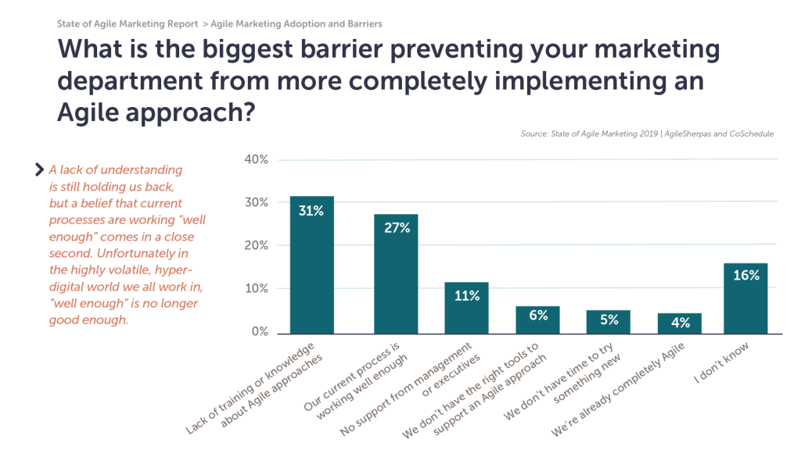
A similar percentage of respondents say they’re sticking with their current process because it’s “working well enough” (27% this year, 26% in 2018).
The percentage of marketers facing a lack of executive support nearly doubled this year, going from 5.3% to 11% (again, a likely correlation to our respondents shifting to managers/associates).
All other responses — we don’t have the right tools, we don’t have time, we’re already completely Agile, and don’t know — stayed steady at 2018 levels.
Two Roads Diverged…
According to our respondents, 50% of traditional marketing teams plan to go Agile within the year. The choice is becoming clearer and clearer: you can optimize your process using tried-and-true Agile principles, or you can spend the next decade trying to catch up with those that do.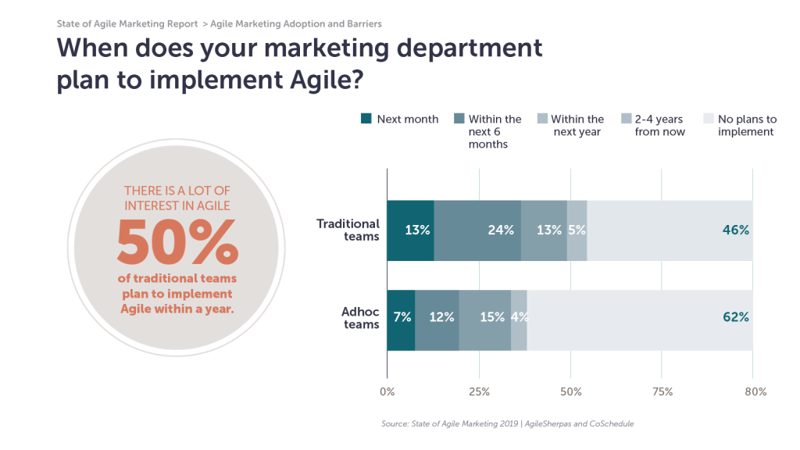
Which path will you choose, Agile transformation, or the status quo?
And if you choose the former, will you do it right by getting educated and building your own custom hybrid, or will you try to shoehorn your marketing work into Agile software frameworks?
Having seen exactly what Agile can do for marketing teams, I sincerely hope you choose the first option for both those questions.
If you’re feeling overwhelmed and not sure where to start or what to do, just reach out and we’ll lend a hand. We’re AgileSherpas, and that’s what we do.




